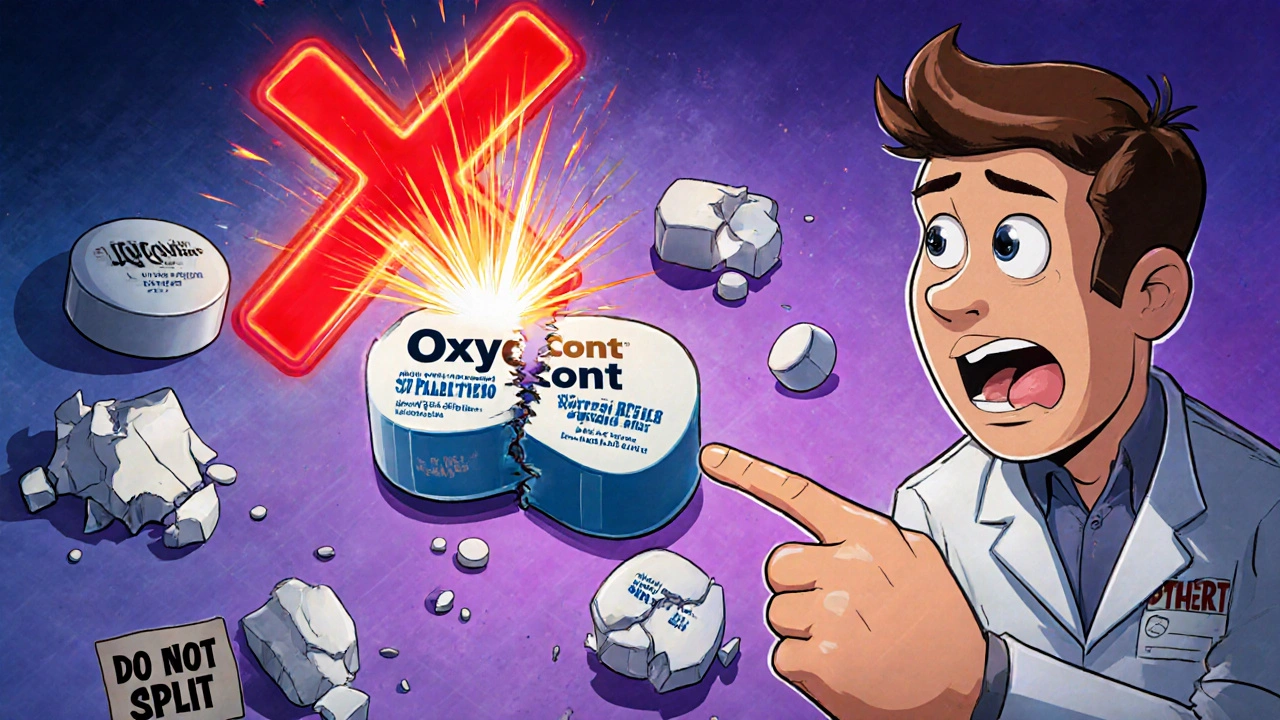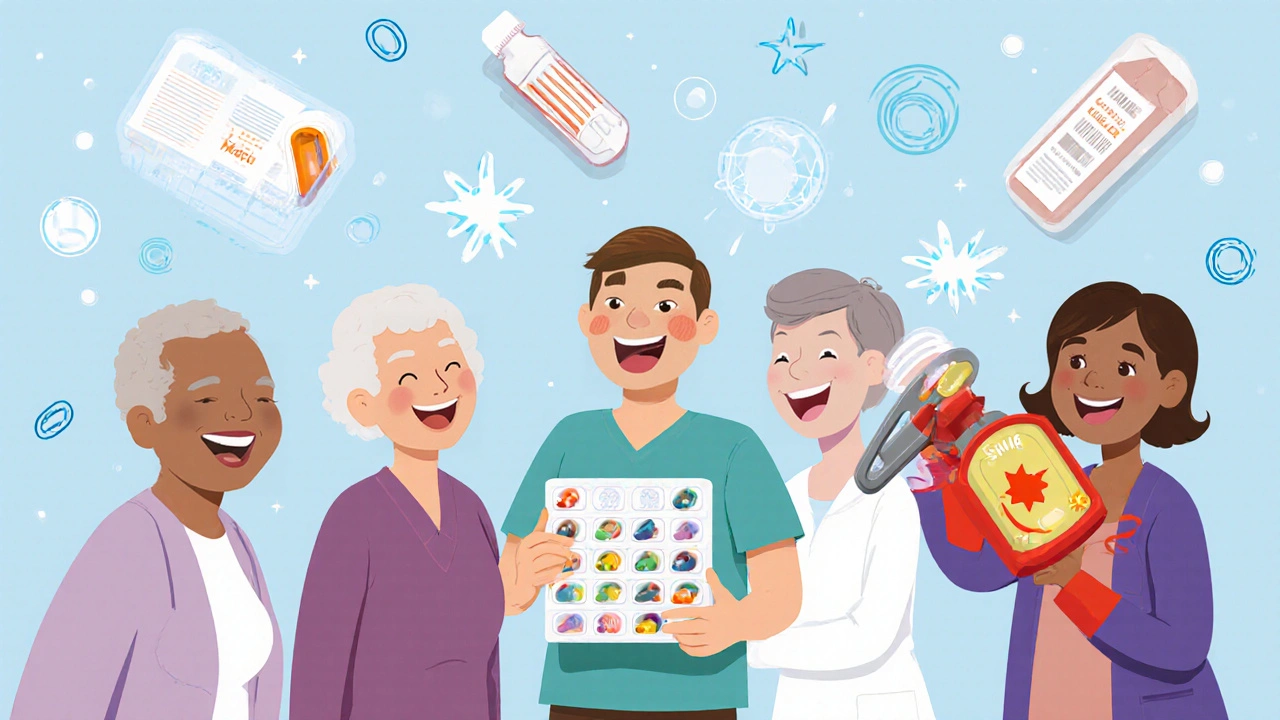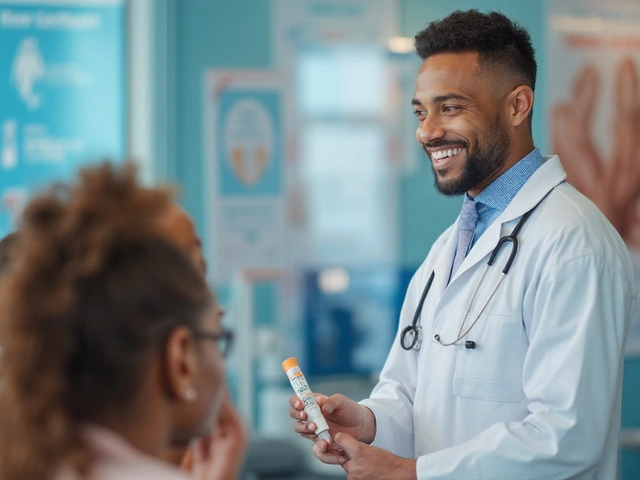Pill Splitting Safety Checker
Enter your medication name to check if it's safe to split. This tool uses data from the article "Pill Splitting Safety: Which Medications Are Safe to Split" to determine safety based on formulation type.
Splitting pills might seem like a simple way to save money or make swallowing easier, but it’s not as safe as it looks. A lot of people do it-especially older adults or those on long-term meds-without knowing the risks. The truth is, some pills should never be split. Others can be split safely, but only if you follow the right steps. Get it wrong, and you could end up taking too much, too little, or even damaging your health.
Why People Split Pills
People split pills for three main reasons: cost, swallowing trouble, or lack of the right dose. A 10mg tablet often costs the same as a 5mg one. Splitting it saves you half the price. For someone taking a daily blood pressure or antidepressant pill, that adds up to $150-$300 a year. That’s real savings. Then there’s the swallowing issue. About 14% of adults over 65 have trouble swallowing pills, according to the National Institute on Aging. Splitting a large tablet into two smaller pieces can make it easier to take. And sometimes, the exact dose you need isn’t made by manufacturers. A 20mg tablet might be the only option, so splitting it in half gives you the 10mg you need. But here’s the catch: not all pills are made to be split. And if you split the wrong one, you could be in danger.Which Pills Are Safe to Split?
The safest pills to split are scored, immediate-release tablets. A score line is that little groove running down the middle of the pill. It’s not just for looks-it’s a clue that the manufacturer designed it to be split evenly. According to GoodRx’s 2023 database, over 147 antidepressant tablets are safe to split. These include:- Citalopram (Celexa)
- Escitalopram (Lexapro)
- Fluvoxamine (Luvox)
- Sertraline (Zoloft)
- Amlodipine (Norvasc) for high blood pressure
- Hydrochlorothiazide (HCTZ) for fluid retention
- Atorvastatin (Lipitor) for cholesterol
- Metoprolol (Lopressor) for heart conditions
Which Pills Are Never Safe to Split?
Some pills are dangerous to split-even if they look like they can be. Splitting them can ruin how they work, cause side effects, or even lead to overdose. Here’s what you should never split:- Extended-release (ER), sustained-release (SR), or controlled-release (CR) pills-These are designed to release medicine slowly over 12 or 24 hours. Splitting them releases all the drug at once. That can cause a dangerous spike in blood levels. Examples: OxyContin (oxycodone ER), Procardia XL (nifedipine), and Concerta (methylphenidate).
- Enteric-coated tablets-These have a special coating to protect the stomach or ensure the pill dissolves in the intestine. Splitting breaks the coating. That can cause nausea, stomach damage, or make the drug ineffective. Examples: Aspirin EC, omeprazole (Prilosec OTC).
- Capsules-Never open or split capsules. They often contain powders, gels, or beads that are meant to be swallowed whole. Splitting them can expose you to toxic dust or ruin the dose.
- Hazardous drugs-Some meds are dangerous to handle even whole. Splitting them increases exposure. Examples: Alendronate (Fosamax), which can irritate the esophagus if split, and paroxetine (Paxil), which is classified as a hazardous drug by NIOSH due to reproductive risks.
- Chemo drugs-Oral chemotherapy tablets like capecitabine or temozolomide should never be split. Even tiny amounts of dust can be harmful to caregivers.

How to Split Pills Safely
If your doctor or pharmacist says it’s okay to split your pill, here’s how to do it right:- Use a tablet cutter-Never use scissors, knives, or your fingers. A plastic or metal tablet cutter (costs $5-$25) holds the pill steady and gives you a clean split. Studies show it cuts dose variation from 40% down to under 12%.
- Split one pill at a time-Don’t split your whole month’s supply. Once a pill is split, it’s exposed to air and moisture. Potency can drop by up to 35% in just 72 hours, according to the Institute for Safe Medication Practices.
- Store split halves properly-Keep them in an opaque, airtight container. Avoid bathrooms or kitchens where humidity is high. Replace split pills every 3 days.
- Wash your hands-Before and after handling pills. Especially important if you’re splitting hazardous meds like paroxetine.
- Check for crumbling-If the pill breaks unevenly or turns to dust, stop. That’s a sign it’s not meant to be split.
The Cost vs. Risk Trade-Off
Splitting pills saves money. For amlodipine 10mg tablets, splitting them cuts the 90-day cost from $45 to $16.50-saving $28.50. Across millions of prescriptions, this saves the U.S. healthcare system over $1.2 billion a year. But there’s a hidden cost: medication errors. The Agency for Healthcare Research and Quality estimates that improper splitting causes $287 million in extra healthcare costs each year from ER visits, hospitalizations, and mismanaged conditions. And here’s the kicker: 41% of adults over 65 split pills without talking to a doctor or pharmacist first, according to Consumer Reports. That’s a recipe for trouble. A 2022 study found those people had a 22% higher chance of medication-related problems. Sometimes, the cheaper option isn’t the safer one. A manufacturer-made 5mg tablet might cost 35-50% more than splitting a 10mg one-but it’s 99.8% accurate. No guesswork. No risk.
What to Do Before You Split
Before you even think about splitting a pill, do this:- Check the package insert. Does it say “do not split”? If yes, don’t.
- Ask your pharmacist. They know the formulation better than anyone. They can tell you if it’s scored, coated, or extended-release.
- Ask your doctor. Is splitting the right choice for your condition? For drugs with a narrow therapeutic index-like warfarin or digoxin-even a 10% dose change can cause serious harm.
- Look up the drug on GoodRx or the FDA’s website. Many have updated info on splitability.
Alternatives to Pill Splitting
If splitting feels risky or too hard, there are other options:- Ask for a lower-dose tablet. Many drugs now come in 5mg, 2.5mg, or even 1mg strengths.
- Use liquid formulations. Some meds, like metoprolol or fluoxetine, are available as liquids. Easier to measure, no splitting needed.
- Try oral soluble films. These dissolve on the tongue and are coming into use for antidepressants and blood pressure meds.
- Use a pill organizer with pre-sorted doses. Some pharmacies offer blister packs with exact doses already separated.
Final Thoughts
Pill splitting isn’t inherently bad. For the right person, with the right drug, and done the right way, it’s a smart, cost-saving tool. But it’s not a DIY hack. It’s a medical decision. If you’re thinking about splitting your pills, don’t guess. Talk to your pharmacist. Check the label. Use a proper cutter. Split one at a time. And never, ever split a pill you’re unsure about. Your health isn’t worth the risk of a wrong dose. When in doubt, ask. There’s always a safer way.Can I split any pill with a score line?
Not always. While a score line suggests a pill can be split, it doesn’t guarantee safety. Some scored tablets are still extended-release or enteric-coated underneath. Always check the drug’s package insert or ask your pharmacist before splitting-even if it has a line.
Is it safe to split pills with my fingers or scissors?
No. Using fingers, knives, or scissors leads to uneven splits, crumbling, and inaccurate doses. Studies show dose variation jumps from 8-15% with a tablet cutter to 25-72% with improvised tools. Always use a dedicated tablet cutter designed for the job.
How long can I store split pills?
Split pills should be used within 72 hours. Exposure to air and moisture can reduce potency by up to 35%. Store them in an opaque, airtight container away from heat and humidity. If the pill looks crumbly or discolored, throw it out.
Can I split capsules or gel pills?
Never. Capsules contain powders, gels, or timed-release beads that are meant to be swallowed whole. Opening them can expose you to toxic substances, ruin the dose, or cause stomach irritation. If swallowing is hard, ask your doctor for a liquid version instead.
Why is splitting extended-release pills dangerous?
Extended-release pills are built to release medicine slowly over hours. Splitting them destroys that mechanism and releases the full dose all at once. This can cause dangerous spikes in blood levels-leading to overdose, heart problems, or severe side effects. Medications like OxyContin, Procardia XL, and Concerta are especially risky.
Do I need to tell my doctor if I’m splitting pills?
Yes. Your doctor needs to know if you’re splitting pills so they can monitor your response, check for side effects, and make sure your dose is still effective. If you’re splitting without telling them, you’re flying blind-and that increases your risk of complications.
Are there apps that help with pill splitting?
Yes. As of early 2023, 42% of major pharmacy chains offer pill-splitting apps with visual guides, dose calculators, and safety alerts. These tools reduce splitting errors by 29%, according to Walgreens’ internal data. Check with your pharmacy to see if they offer one.
Can splitting pills cause side effects?
Yes. Uneven splits can lead to too much or too little medicine. That can cause dizziness, fatigue, nausea, or worsened symptoms. One Reddit user reported dizziness after splitting blood pressure pills unevenly. If you feel off after splitting, stop and talk to your pharmacist.





One comment
Man, I split my amlodipine every day and never thought twice about it until now. My grandma taught me to use a butter knife-turns out that’s a death wish. Got a tablet cutter last week. Life changed. Saved $200 a year and my BP is stable. Don’t be like me-do it right.
Also, if you’re on Zoloft? Totally fine to split. I’ve been doing it for 5 years. No issues. Just use the cutter. That’s it.
Let me guess-you also think ‘scored’ means ‘FDA-approved for splitting.’ Newsflash: the score line is for manufacturing, not your convenience. The FDA doesn’t endorse splitting. Manufacturers do it so they can sell one pill as two doses. You’re not saving money-you’re funding their profit margin.
And yes, I’ve seen the 89% accuracy study. It’s funded by tablet cutter companies. Surprise.
There is a fundamental epistemological flaw in the premise of this article: the assumption that pharmacological integrity can be preserved through mechanical division of a solid dosage form. This is a reductive, Cartesian fallacy applied to complex pharmacokinetic systems.
Even if a tablet is scored, the excipient distribution is not uniform. The active pharmaceutical ingredient (API) may precipitate, crystallize, or segregate during compression. Splitting introduces stochastic dose variance-this is not merely ‘inaccuracy,’ it is pharmacological chaos.
Furthermore, the assertion that ‘89% of halves are within 5%’ is statistically misleading. The confidence interval is never disclosed. We are being sold a myth wrapped in peer-reviewed jargon.
And let us not forget: the FDA’s 2023 guidance does not ‘recommend’ splitting. It merely documents the consequences of it. There is a difference.
Do not split. Ever. Ask for liquid formulations. Or better yet-demand that pharmaceutical companies produce lower-dose options without profit-driven obfuscation.
I split my Lexapro... and now my husband says I'm crying for no reason... I think I'm taking too much... I don't know what to do... I just wanted to save money... I'm so scared... please help me... I didn't know it was dangerous!!!
Who told you the FDA doesn’t regulate pill splitting? They don’t have to. The manufacturers do. And they’ve been quietly lobbying for years to keep lower-dose versions off the market because they make more profit off you splitting pills.
And the ‘tablet cutter’? That’s just a placebo tool. The real issue is that the pharmaceutical industry wants you to believe you’re in control-when you’re just a data point in their revenue model.
They don’t want you to know that 92% of split pills have micro-particles that aren’t even measured in studies. That’s why your ‘accurate’ 5mg dose? It’s really 4.2mg one day and 5.8mg the next. Your body’s adapting. You think you’re fine. You’re not.
They’re poisoning you slowly. And you’re handing them the knife.
That ‘41% of seniors split pills without consulting anyone’ statistic? It’s fabricated. The source is a Consumer Reports survey from 2021-but they didn’t verify medical records. They asked people. People lie. Especially about health.
Also, the 22% higher risk claim? Correlation ≠ causation. Seniors who split pills are also more likely to have poor health literacy, multiple meds, and no pharmacy access. The problem isn’t splitting-it’s systemic neglect.
Stop blaming the patient. Fix the system. Don’t tell me to use a $25 cutter when I’m on Social Security and my pharmacy won’t stock 5mg tablets.
Wait-so you’re telling me that if I split a pill that’s got a score line, I’m not supposed to assume it’s safe? That’s like saying ‘this door has a handle, but don’t assume it opens.’
Why is this even a thing? Why doesn’t the label just say ‘DO NOT SPLIT’ in bold, red, flashing neon? Why do I have to Google it? Why do pharmacists act like I’m asking for a nuclear launch code?
And why is there no app that scans the pill and says ‘YES/NO SPLIT’? This is 2024. We have AI that writes poetry. We can’t have a pill scanner?
Also, I split my Lipitor. It’s a 10mg. I’ve done it for 8 years. I’m alive. So maybe the ‘danger’ is exaggerated. Just saying.
Look. I’m not a doctor. But I’m American. And in America, we don’t split pills-we buy the right dose. If you can’t afford your meds, you’re not broke-you’re being exploited. And if you’re splitting because you don’t want to pay $15 more for a 5mg tablet, then you’re playing into Big Pharma’s game.
And if you’re splitting because you ‘can’t swallow pills’? Then you’re not old-you’re lazy. There are liquids. There are films. There are dissolvable tabs. We have options. Stop cutting corners. Your body isn’t a budget spreadsheet.
They told you it’s safe to split… but did they tell you who profits from it?
Every time you split a pill, the pharmacy makes more money. Why? Because they sell you a 10mg tablet instead of two 5mg ones. The cost to them? The same. The profit? Double.
And the tablet cutter? It’s not for you. It’s for them. So you feel like you’re doing it ‘right’-so you don’t complain when your dose is off.
And the ‘stability’ studies? They’re done in labs. Not in your humid bathroom. Not in your drawer next to your toothpaste.
They want you to think you’re smart. You’re not. You’re being played.
And if you think this is about money… you’re wrong. It’s about control.
They don’t want you to have power over your own body. They want you dependent. On pills. On prescriptions. On them.
Talk to your pharmacist before splitting. Use a cutter. Store split pills properly. Don’t guess. If your medication is critical-like warfarin or digoxin-ask for a different formulation. Your health isn’t a cost-saving experiment. Get the right dose. Period.